Note: This website was automatically translated, so some terms or nuances may not be completely accurate.
What kinds of programs do parents and children watch together? Why family viewing matters
How much time do you think people spend watching TV at home each day? In the Kanto region in 2017, it was 8 hours and 2 minutes per household. Many might be surprised, thinking "That long??" Per person, it's 4 hours and 18 minutes, but because viewers rotate within the home, the total household viewing time reaches about 8 hours.
According to Video Research Ltd.'s "ACR/ex" survey, over half of respondents consider "TV essential for family bonding." This time, we'll examine the importance of family TV viewing.
The number one program popular with parents and children is variety shows!
The program ratings you often see are household ratings. Whether one person watches or multiple people watch, it counts as one household. Therefore, even with the same household rating, "watching as a family" means more people are watching compared to "watching alone."
When we think of families, many imagine young children with their parents. This time, we focused on viewing by children in elementary school or younger and their parents (hereafter referred to as parent-child viewing).
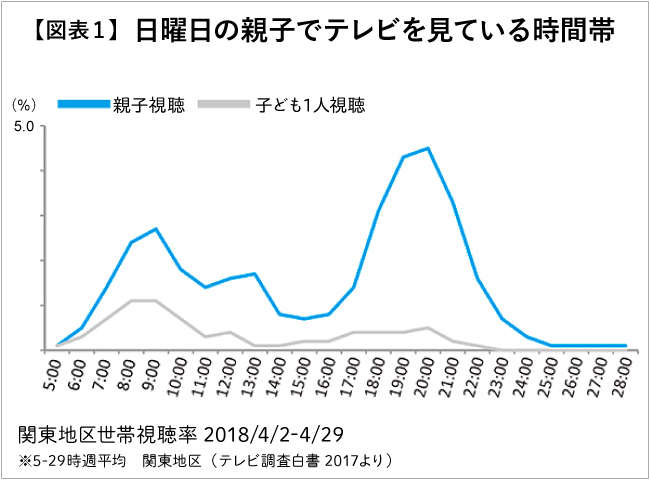
First, looking at when parent-child viewing peaks, we examined Sundays when families are most likely home. Parent-child viewing exceeded children watching alone in every time slot (Figure 1). Parent-child viewing concentrated in the "morning" and "evening to night" periods, particularly standing out between 6:00 PM and 9:00 PM, suggesting families relax together watching TV on holiday evenings.
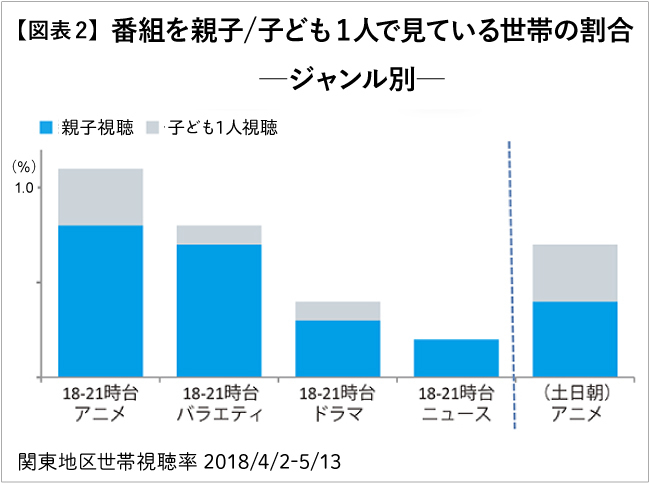
So, what types of programs are frequently watched by parents and children together? (Figure 2) Looking at programs aired from evening to night, while the proportion of parent-child viewing is relatively low overall, anime shows a comparatively higher share. Although many anime are made for children, it's clear that the proportion watched "by parents and children together" is higher than that watched "by children alone."
Additionally, weekend morning anime programs are also watched by parents and children together, suggesting parents spend time with their children while they watch TV. Variety shows between 6:00 PM and 9:00 PM are another genre with high parent-child viewing. Variety shows may spark conversation while watched together. On the other hand, dramas and news programs have relatively low parent-child viewing, perhaps because their content is difficult for young children or not geared towards them.
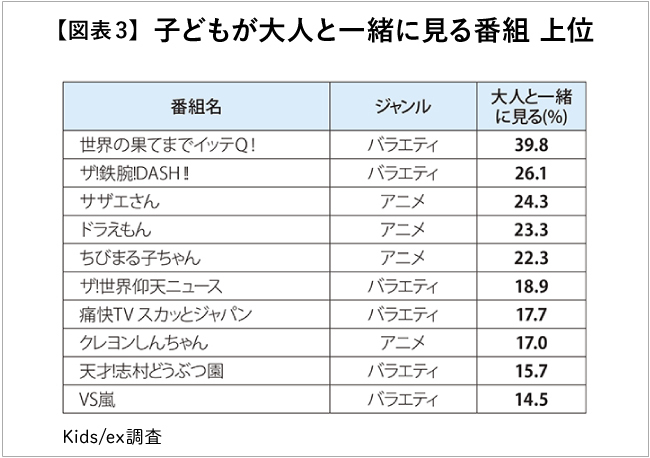
Next, let's examine what types of programs are watched together by parents and children, based on the "Kids/ex" survey targeting children in elementary school and younger (Figure 3). In the 2017 survey, variety shows and anime ranked highest among programs children watch with their parents. The top two programs, "Itte Q! to the Ends of the World!" and "The! Iron Arm! DASH!!", feature celebrities introducing various information from overseas and within Japan, or taking on diverse challenges. These are variety shows enjoyable across a wide age range, from young children to adults.
The selection of variety shows featuring domestic and international information and challenges likely reflects parents' desire not only for lively conversation when watching TV with their children but also for nurturing their intellectual curiosity and emotional development.
In anime, long-running favorites like "Sazae-san" and "Doraemon" consistently rank highly. Many parents likely watched these shows themselves as children, so they probably enjoy them with a sense of familiarity.
Family viewing as a catalyst for expanding each parent and child's favorite programs
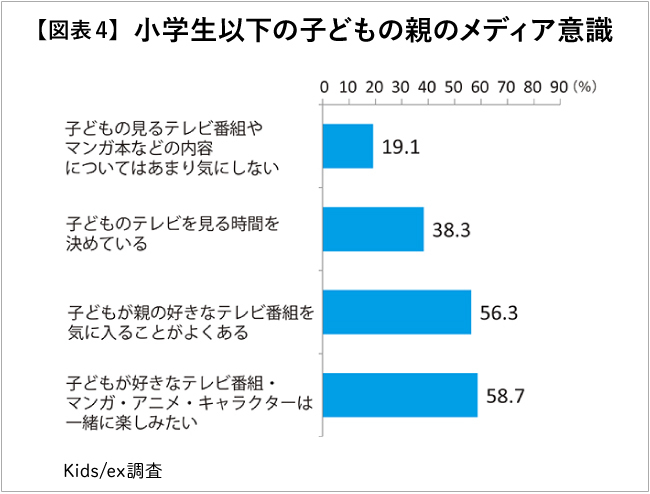
To confirm this background, we examined awareness data from parents with children, also sourced from "Kids/ex" (Figure 4). Approximately 40% of parents "set limits on their child's TV viewing time," while only about 20% "don't pay attention to the content their child watches." This suggests parents are actively involved in their children's TV viewing.
Furthermore, nearly 60% stated they "want to enjoy their child's favorite programs together" or "their child likes programs they enjoy," suggesting both parents and children watch TV together for enjoyment. This shared viewing pleasure likely contributes to the image introduced earlier that "TV is essential for family bonding."
Parents likely watch anime alongside their children because it's what the children want to see, while variety shows are often programs parents want to show their children or enjoy together. Even programs children wouldn't choose on their own can become favorites when watched with someone who enjoys them, potentially leading children to eventually select those shows themselves. This parent-child viewing, which broadens the range of favorite programs across different age groups, seems to be a crucial way television is consumed.
Programs with high favorability are those "viewable by the family"

Next, let's examine the relationship between a program's "favorability rating" and its "family-friendly" image based on the program charts (Figure 5). Looking at the favorability ratings of the top 10 programs perceived as "family-friendly," dramas show little difference from the average, suggesting that being a "family-friendly" type doesn't significantly impact a program's favorability.
However, variety shows labeled as "watched by families" have higher favorability ratings than the average. Watching together as a family likely sparks conversation, fostering an impression of family togetherness, which contributes to the program's favorability.
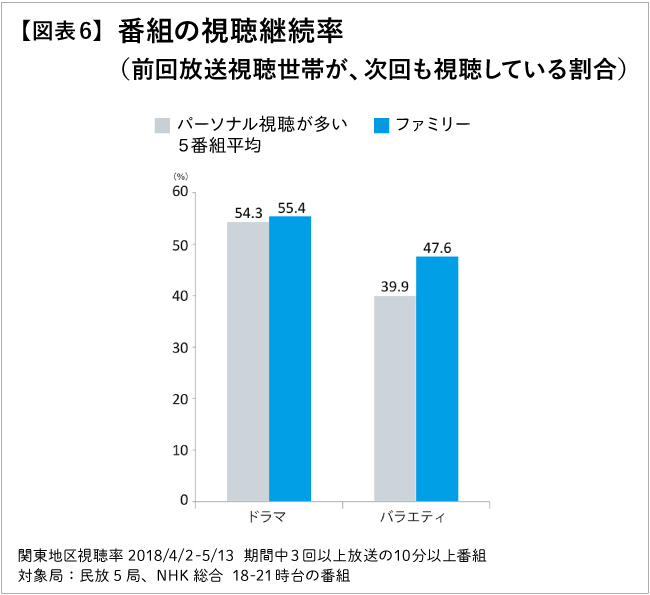
Furthermore, examining viewership retention rates (the percentage of households continuing to watch the next episode) from ratings data reveals that for variety shows, family viewing has a higher retention rate than solo viewing (personal viewing) (Figure 6). Conversely, for dramas, both personal and family viewing show high retention rates, suggesting that whether watched alone or with family has little significant impact. While dramas often feature serialized stories and inherently have high retention rates, this appears more influenced by the drama's setting and plot development than by viewing style.
While there are many different types of programs and ways to watch them, we've seen that family viewing strongly contributes to family bonding for viewers. For programs, it seems to have the effect of boosting loyalty, as it makes it easier to gain fans and encourages repeat viewings. Family viewing appears to be a win-win for both the program and its audience.
This data on family viewing highlights television's unique characteristics. TV can cater to everyone's entertainment time by offering diverse programming: variety shows that become more engaging when watched together, and dramas where individuals can immerse themselves in beloved story worlds. Furthermore, TV's ability to connect different generations through shared viewing experiences is another defining trait.
ACR/ex data also shows that people who feel family time has increased tend to have relatively higher levels of awareness such as "satisfaction with current living standards" and "self-confidence." It can be inferred that family time enhances personal fulfillment and serves as a driving force for leading an active life. Creating this precious time is surely one of television's values.
We hope television will continue to produce programs that can be enjoyed by parents and children together, creating joyful moments of family togetherness.
Kids/ex Survey Overview
Survey Area: Within 50km of Tokyo
Survey Participants: Individuals aged 3 to 12 years old (excluding junior high school students)
*Survey responses entered by parents or parent representatives
Target Sample Size: Approximately 600 people
Survey Period: October 2017
Survey Method: Electronic survey form
Program Chart Survey Overview
Survey area: Within 30km of Tokyo
Survey Participants: Individuals aged 13 to 69
Target Sample Size: Approximately 800 people
Survey Period: November 2017
Survey Method: Door-to-door questionnaire distribution method
Was this article helpful?
Newsletter registration is here
We select and publish important news every day
For inquiries about this article
Author

Naoko Hirota
Video Research Ltd.
Solution Business Division TV & Media Solutions Department
After working at a research firm, joined Video Research Ltd. in 2012. Primarily analyzes in-house survey data, including ratings, to help solve challenges for TV stations and advertising agencies. Hobbies include piano—which I never seem to get better at—and attending live concerts.
